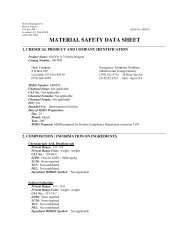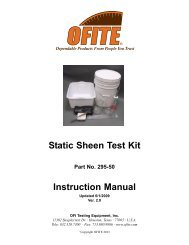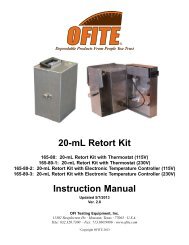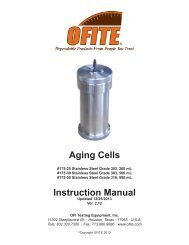Instructions - OFI Testing Equipment, Inc.
Instructions - OFI Testing Equipment, Inc.
Instructions - OFI Testing Equipment, Inc.
Create successful ePaper yourself
Turn your PDF publications into a flip-book with our unique Google optimized e-Paper software.
<strong>OFI</strong> <strong>Testing</strong> <strong>Equipment</strong> – 146-00 <strong>Instructions</strong> – Workover and Completion Fluids Test Kit Page 3 of 17<br />
Procedure - Whole Mud Alkalinity, P m<br />
1. Measure 1 ml of drilling mud into the titration dish and dilute with 25 to 50 ml of distilled water.<br />
2. Add four or five drops of Phenolphthalein Indicator solution and while stirring, titrate with N/50 Sulfuric acid<br />
solution until the pink color just disappears. If the end point color change cannot be seen, it can be taken when<br />
the pH drops to pH 8.3 as measured on a pH meter. If cement contamination is suspected, the titration must be<br />
performed as rapidly as possible and the end-point is reported as the first disappearance of the pink color.<br />
3. Report the Phenolphthalein alkalinity of the whole mud, P m , as the number of milliliters of N/50 Sulfuric acid<br />
required per milliliter of mud.<br />
Procedure - Lime Content, Estimated<br />
1. Determine the P f and P m of the filtrate and whole mud as described in the Alkalinity test.<br />
2. Determine the volume fraction of water F w , using the percent of water from the liquid and solids as<br />
determined in a Retort analysis.<br />
F w = % Water by Volume<br />
100<br />
3. Report the Lime Content of the Fluid:<br />
Alternate Alkalinity Procedure<br />
Estimated Lime, lb/bbl = 0.26 (P m - F w x P f )<br />
Estimated Lime, kg/m 3 = 0.742 (P m - F w x P f )<br />
The P1/P2 Back Titration method is used to overcome some limitations of the P f /M f alkalinity method. A serious<br />
problem arises with anionic organic thinners, filtrate reducers and their degradation products which may contribute to a<br />
large portion of the alkalinity value, as well as masking the end point color change. These organic materials make a<br />
particularly large contribution to the M f alkalinity and thus render the test highly inaccurate in treated with organic<br />
thinners. If organic thinners are present in large amounts, the P1/P2 method should be used, but it also has its<br />
limitations. See the table below:<br />
Method Advantages Disadvantages<br />
P f /M f Traditional Method Interference with the M f titration<br />
2 Titrations, 1 Sample Bicarbonate result normally too high<br />
P1/P2 Eliminates interference 3 Titrations with 3 samples<br />
in M f titrations<br />
Caustic measurement critical<br />
Uses a toxic material - BaCl 2<br />
<strong>OFI</strong>TE • 11302 Steeplecrest Dr. • Houston, TX 77065 USA • Phone (832) 320-7300 • http://www.ofite.com<br />
Version 1.1<br />
Date 03-04-03
















